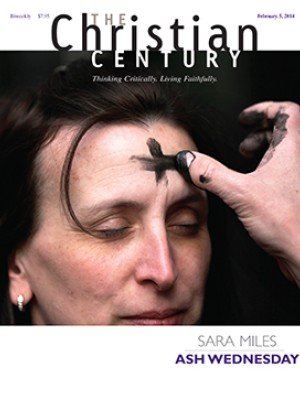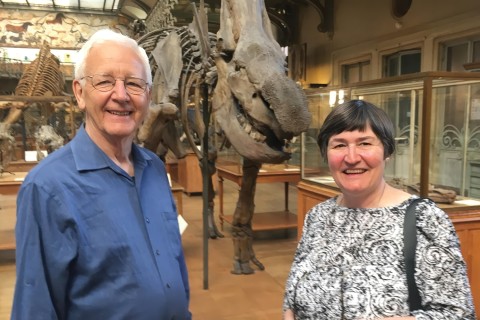Breast-feeding, on the rise, remains an issue in pews
Jesus was breast-fed. It’s a point often made by mothers who want to breast-feed in church but know others would prefer that they retreat to the nursery or find an out-of-the-way bench. Another point they make: breast-feeding is part of God’s plan—so why not do it in church?
“Breasts were made to feed a baby,” said Misti Ryan, a Christian and a lactation consultant in Texas, whose business has a cross in its logo.
A mother can breast-feed modestly and should be allowed to nurse in church if she wants to, said Ryan, who has nursed five children in her Baptist congregation.
Pope Francis addressed the issue in December, commenting to a journalist about a young mother and infant who had come to a recent general audience: “She was shy and didn’t want to breast-feed in public, while the pope was passing,” Francis recalled. “I wish to say the same to humanity: give people something to eat! That woman had milk to give to her child; we have enough food in the world to feed everyone.”
Read our latest issue or browse back issues.
Breast-feeding advocates delighted in the pope’s acceptance of breast-feeding as a natural act appropriate in a sacred place.
Still, many Americans—at least according to a series of informal conversations and online forums—feel queasy about breast-feeding in the pews.
Though American mothers are increasingly choosing to breast-feed and 77 percent of babies are nursed for at least some part of their infancy, the sight of a woman breast-feeding in church can still elicit disapproval.
Generally it’s a quiet disapproval: no one wants to be seen as the one who denied food to a baby or denied its mother the opportunity to hear the Word of God.
Mary Fischer, a popular online blogger on parenting issues who is known as “The Mommyologist,” wrote in September about the “5 Places Moms Need to Breastfeed Discreetly,” listing church as number five.
“It’s wonderful when moms want to bring the kids to church and nurture their faith early on,” she wrote. “But a cover-up is a necessity with a baby in tow. Do I really have to elaborate here?”
The post inspired hundreds of comments, many of them taking Fischer to task. One commentator replied to Fischer: “You must have some psychological damage to be so freaked out about other women feeding their babies the way nature/God intended.”
Fischer, the commenter concluded, “pretty obviously did not breast-feed or she wouldn’t have drawn such ridiculous conclusions.” Actually, Fischer did breast-feed her son—who is now seven—but not in church.
“There are certain places where it really does make people uncomfortable,” she said. “The last thing I want to do is be listening to a sermon and look over and see boobs. If you need to do it, fine. Just make sure you have a cover-up.”
At the Catholic church she attends in Connecticut, Fischer said she has never seen another mother breast-feeding, but if she did, she wouldn’t say anything to the mother. “I would never ask anybody to cover up,” she said, adding that she might go home and grouse a bit to a friend.
Elizabeth Dalman, a new mother who lives near Anaheim, California, said the reaction to her breast-feeding in her Baptist church has always been polite, but she can tell at times that fellow congregants feel uncomfortable.
Dalman’s son, now ten months, hates to nurse under those apron-like cover-ups that hide a nursing mothers’ breasts— but also babies’ heads. After she nursed in her church’s lobby recently, a woman informed her that the church provides such cover-ups.
In church, most people don’t want to get into a debate about breast-feeding, no matter their stance on the issue. But they may often feel more motivated to discuss the topic elsewhere—such as on the Internet.
A group of Mormon women formed Latter Day Lactivism and created a website to make breast-feeding an accepted part of life in the Church of Jesus Christ of Latter-day Saints, including in the ward houses, as local congregations are known.
“We represent the rights of LDS women to breast-feed their children in their ward houses,” the group’s mission statement reads. “We maintain that it is neither immodest nor immoral for a woman to breast-feed her child as openly as she pleases.”
Many churches, including ones in heavily Mormon Utah, where nursing rates are nine percentage points higher than the national average, are welcoming to nursing mothers.
The U.S. Conference of Catholic Bishops has no policy on breast-feeding but encourages the practice in its guidelines for natural family planning education, according to Theresa Notare, assistant director of the USCCB’s Natural Family Planning Program.
An Internet search for meetings of La Leche League International, the most well-known breast-feeding advocacy group in the United States, finds that many are held in churches. But even a church that hosts La Leche may not feel comfortable for a breast-feeding woman on Sunday.
Barbara Emanuel, executive director of La Leche, says experiences vary from church to church, but it’s a shame that breast-feeding is an issue anywhere, given that “it’s what women’s bodies are made for” and that for millennia “it wasn’t discussed.”
“I don’t think mothers have a right to infringe on other peoples’ right to participate in a service or the right to hear the sermon,” Emanuel said. “But basic baby noises shouldn’t be so disruptive that it would be a problem.” —RNS
This article was edited on January 23, 2014.




